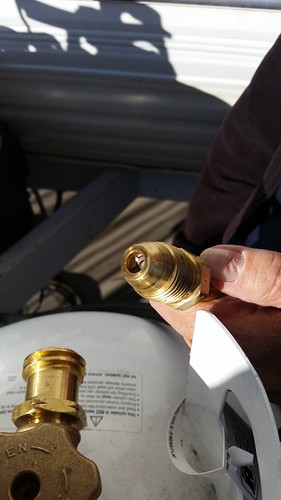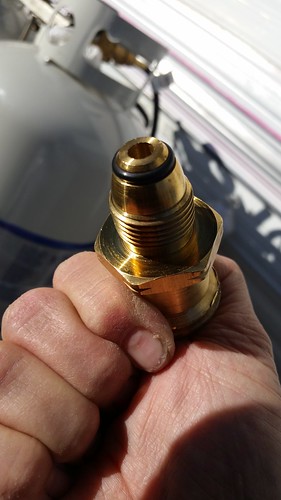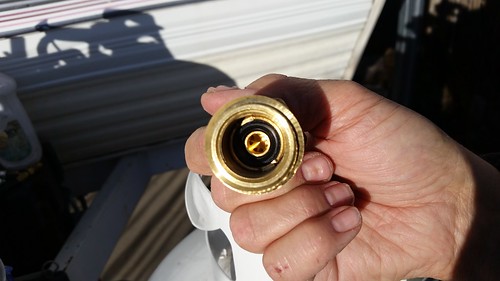Learning About Propane Connectors
Jan. 4th, 2020 06:28 pmLisa and I went to Reno this morning and started the day with a leisurely brunch at the Peppermill (possibly the best meal value with our locals' discount that they have, in my opinion). Well-fed, we went to Safari RV to seek out the adapter to allow us to connect our new large propane bottle to the existing trailer fittings. Now the adapter we bought was not cheap (and appears to cost significantly less online than from Safari), but we were able to hold it in our hands, confirm that it will connect to both one of the large bottles (they had one on display) and to our fittings (we brought a spare fitting with us), and that it had the necessary rubber O rings in the right places. Also, we could see with our own eyes that it was US-made, not a cheap Chinese knock-off.
After dealing with RV parts, we stopped at Smart Foodservice in Reno so that Lisa could look over what they had and see their prices, in order to give her a better handle on what she would need to budget for Westercon 74. We currently expect to buy much of what we need in wholesale quantities in Reno and transport them to Tonopah, so we only need to buy perishables and last-minute stuff from the grocery store there. It was good to have had such a big breakfast before examining the store, as it allowed us to consider the selection academically, not with growling stomachs.
Returning home, it was time to work on installing and connecting the propane adapter. You can skip the rest of this if you are uninterested in the trivia of different types of propane plumbing connectors and why our first attempt to connect things could have led to a very dangerous or even deadly situation.

Here is what the final result looked like, with the large bottle (100 pounds, approximately 23 gallons capacity), the adapter screwed into the valve body, and the hose connecting it to the trailer's propane regulator connected to the adapter. Here's how all of the parts work, and why things almost went disastrously wrong.

Here's a look at the large bottle with nothing plugged into it. According to what research I've been able to do, this is a CGA 510 POL ("Prest-O-Lite" being the brand of the original manufacturer) valve, which is used on larger propane bottles not subject to regulation by the US Department of Transportation and also on other gas cylinders. It uses a left-hand thread so you can't accidentally attach water plumbing fittings to it. Note that the inside of this female fitting is bare metal, with no O-rings or gaskets. Also note that if you open this valve, it will vent gas directly regardless of whether there is anything plugged into it.

This is a smaller 30-pound (approximately 7.5 gallon) bottle that is standard equipment on many recreational vehicle trailers like Lisa's. The valve here is apparently a Type 1 QCC "ACME" valve as mandated for smaller bottles by the US DoT. This valve head will handle both right-hand-thread ACME fittings on the outside ring and the older left-hand POL fittings (like that on Lisa's trailer) on the inside thread. Note that the inside of this female fitting has a rubber O ring that forms a gas-tight seal. Also note that if you open this valve with nothing connected to it, nothing happens; this is a safety measure that requires a proper connector be attached before propane will release.

This is the fitting on the hose that runs from the propane bottle to the regulator that feeds the appliances on the trailer. It is a "hard nose" POL fitting, meaning that the male fitting is solid metal. On the smaller trailer bottles, it nests into the rubber O ring to form a gas-tight seal.
You can't get a good gas-tight seal on a metal-to-metal fitting. While the "hard nose" male fitting will mechanically mesh with the female fitting on the large propane bottle and you can appear to tighten it, it's very difficult if not impossible to get a gas-tight seal. More than one person, including the person from Granite Propane (who supplies Big R's propane) said, "Just pull it tighter." This really isn't a good idea. You shouldn't over-tighten fittings like this, especially ones that need to be removed periodically to refill the container. Besides, even when we tightened it as tight as we dared, it still showed a slow gas leak when we tested it.
By the way, the approved and recommended way to test for a gas leak on a fitting is with ordinary houshold dish soap. Dribble a little dish soap on the fitting area, and if there are leaks, you'll see little bubbles in the soap. It should go without saying (but I'm going to say so because there are people who will blow themselves up doing so anyway) that you should never check for gas leaks with a flame! (Hm, maybe that's how the newer-style fitting got the ACME name; perhaps the Coyote was checking his propane connections for leaks using a match.)

Here's the male end of the Marshall Excelsior Company ME398P adapter. Notice that while it is shaped the same as the "hard nose" POL fitting, this is a "soft nose" fitting that has an O ring built into it. This allows the male "soft nose" fitting to form a gas tight seal with the female fitting on the large bottle.

The other end of the adapter has the interior O ring and both the ACME (outer) and POL (inner) connections.
We connected the adapter to the bottle, plugged the trailer propane hose into the adapter, turned on the gas at the valve, and applied dish soap to the fittings to check for leaks. Success! No bubbles on the connections on the first try! That by itself is unusual, as Lisa expected that there might be a small leak if she hadn't tightened it sufficiently, but she got it right in one.
Now we have a large bottle that holds roughly 3x as much gas as a single "normal" bottle. We still have a second 7.5-gallon bottle connected to the trailer. The propane regulator on the trailer is designed to hold two bottles, with a fail-over valve that will redirect propane to the other bottle if the pressure falls below a critical point. The idea of course is that you then change bottles, but you do have to remember to go look at the regulator periodically as it displays a red bar when it has failed over. Having the larger bottle (with the adapter) on the trailer will be useful when it is "moored" at home, while still allowing us to have both smaller bottles when traveling without having to change fittings or hoses. We'll still have to refill propane bottles, as the 100# bottle is portable (just barely) on the hand truck, but we shouldn't have to go buy propane so often.
After dealing with RV parts, we stopped at Smart Foodservice in Reno so that Lisa could look over what they had and see their prices, in order to give her a better handle on what she would need to budget for Westercon 74. We currently expect to buy much of what we need in wholesale quantities in Reno and transport them to Tonopah, so we only need to buy perishables and last-minute stuff from the grocery store there. It was good to have had such a big breakfast before examining the store, as it allowed us to consider the selection academically, not with growling stomachs.
Returning home, it was time to work on installing and connecting the propane adapter. You can skip the rest of this if you are uninterested in the trivia of different types of propane plumbing connectors and why our first attempt to connect things could have led to a very dangerous or even deadly situation.

Here is what the final result looked like, with the large bottle (100 pounds, approximately 23 gallons capacity), the adapter screwed into the valve body, and the hose connecting it to the trailer's propane regulator connected to the adapter. Here's how all of the parts work, and why things almost went disastrously wrong.

Here's a look at the large bottle with nothing plugged into it. According to what research I've been able to do, this is a CGA 510 POL ("Prest-O-Lite" being the brand of the original manufacturer) valve, which is used on larger propane bottles not subject to regulation by the US Department of Transportation and also on other gas cylinders. It uses a left-hand thread so you can't accidentally attach water plumbing fittings to it. Note that the inside of this female fitting is bare metal, with no O-rings or gaskets. Also note that if you open this valve, it will vent gas directly regardless of whether there is anything plugged into it.

This is a smaller 30-pound (approximately 7.5 gallon) bottle that is standard equipment on many recreational vehicle trailers like Lisa's. The valve here is apparently a Type 1 QCC "ACME" valve as mandated for smaller bottles by the US DoT. This valve head will handle both right-hand-thread ACME fittings on the outside ring and the older left-hand POL fittings (like that on Lisa's trailer) on the inside thread. Note that the inside of this female fitting has a rubber O ring that forms a gas-tight seal. Also note that if you open this valve with nothing connected to it, nothing happens; this is a safety measure that requires a proper connector be attached before propane will release.

This is the fitting on the hose that runs from the propane bottle to the regulator that feeds the appliances on the trailer. It is a "hard nose" POL fitting, meaning that the male fitting is solid metal. On the smaller trailer bottles, it nests into the rubber O ring to form a gas-tight seal.
You can't get a good gas-tight seal on a metal-to-metal fitting. While the "hard nose" male fitting will mechanically mesh with the female fitting on the large propane bottle and you can appear to tighten it, it's very difficult if not impossible to get a gas-tight seal. More than one person, including the person from Granite Propane (who supplies Big R's propane) said, "Just pull it tighter." This really isn't a good idea. You shouldn't over-tighten fittings like this, especially ones that need to be removed periodically to refill the container. Besides, even when we tightened it as tight as we dared, it still showed a slow gas leak when we tested it.
By the way, the approved and recommended way to test for a gas leak on a fitting is with ordinary houshold dish soap. Dribble a little dish soap on the fitting area, and if there are leaks, you'll see little bubbles in the soap. It should go without saying (but I'm going to say so because there are people who will blow themselves up doing so anyway) that you should never check for gas leaks with a flame! (Hm, maybe that's how the newer-style fitting got the ACME name; perhaps the Coyote was checking his propane connections for leaks using a match.)

Here's the male end of the Marshall Excelsior Company ME398P adapter. Notice that while it is shaped the same as the "hard nose" POL fitting, this is a "soft nose" fitting that has an O ring built into it. This allows the male "soft nose" fitting to form a gas tight seal with the female fitting on the large bottle.

The other end of the adapter has the interior O ring and both the ACME (outer) and POL (inner) connections.
We connected the adapter to the bottle, plugged the trailer propane hose into the adapter, turned on the gas at the valve, and applied dish soap to the fittings to check for leaks. Success! No bubbles on the connections on the first try! That by itself is unusual, as Lisa expected that there might be a small leak if she hadn't tightened it sufficiently, but she got it right in one.
Now we have a large bottle that holds roughly 3x as much gas as a single "normal" bottle. We still have a second 7.5-gallon bottle connected to the trailer. The propane regulator on the trailer is designed to hold two bottles, with a fail-over valve that will redirect propane to the other bottle if the pressure falls below a critical point. The idea of course is that you then change bottles, but you do have to remember to go look at the regulator periodically as it displays a red bar when it has failed over. Having the larger bottle (with the adapter) on the trailer will be useful when it is "moored" at home, while still allowing us to have both smaller bottles when traveling without having to change fittings or hoses. We'll still have to refill propane bottles, as the 100# bottle is portable (just barely) on the hand truck, but we shouldn't have to go buy propane so often.